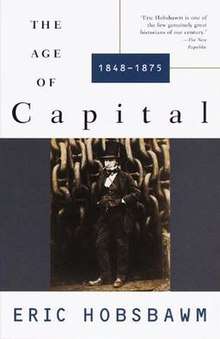The Age of Capital: 1848–1875
The Age of Capital: 1848–1875 is a book by Eric Hobsbawm, first published in 1975. It is the second in a trilogy of books about "the long 19th century" (coined by Hobsbawm), preceded by The Age of Revolution: Europe 1789–1848 and followed by The Age of Empire: 1875–1914. A fourth book, The Age of Extremes: The Short Twentieth Century, 1914–1991, acts as a sequel to the trilogy.
 | |
| Author | Eric Hobsbawm |
|---|---|
| Cover artist | Robert Howlett, photograph of Brunel by the launching chains of the SS Great Eastern, 1857 |
| Country | United Kingdom, United States |
| Language | English |
| Subject | History |
| Publisher | Weidenfeld & Nicolson (UK) Vintage Books (U.S.) |
Publication date | 1975 |
| Pages | 384 |
| ISBN | 978-0-297-76992-7 |
| Preceded by | The Age of Revolution: Europe 1789–1848 |
| Followed by | The Age of Empire: 1875–1914 |
Hobsbawm analyzed the 19th and 20th century processes of modernization using what he calls the dual revolution thesis, which recognized the dual importance of the French Revolution and the Industrial Revolution as midwives of modern European history, and (through the connections of colonialism and imperialism) world history.
Contents
- Part I. Revolutionary Prelude
- 1. "The Springtime of Peoples"
- Part II. Developments
- 2. The Great Boom
- 3. The World Unified
- 4. Conflicts and War
- 5. Building Nations
- 6. The Forces of Democracy
- 7. Losers
- 8. Winners
- 9. Changing Society
- Part III. Results
- 10. The Land
- 11. Men Moving
- 12. City, Industry, the Working Class
- 13. The Bourgeois World
- 14. Science, Religion, Ideology
- 15. The Arts
- 16. Conclusion
gollark: <@!202992030685724675> 0
gollark: Abusing Algebra and Zero Division for Fun and Profit.
gollark: If we assume that anything divided by 0 is 0 then:1 / 0 = 0Multiply both sides of that by 0 and1 = 0
gollark: DOWN WITH RTX!
gollark: If we assume that anything divided by 0 is 0 then:
This article is issued from Wikipedia. The text is licensed under Creative Commons - Attribution - Sharealike. Additional terms may apply for the media files.